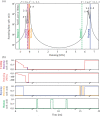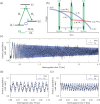A compact cold-atom interferometer with a high data-rate grating magneto-optical trap and a photonic-integrated-circuit-compatible laser system
- PMID: 36050325
- PMCID: PMC9436985
- DOI: 10.1038/s41467-022-31410-4
A compact cold-atom interferometer with a high data-rate grating magneto-optical trap and a photonic-integrated-circuit-compatible laser system
Abstract
The extreme miniaturization of a cold-atom interferometer accelerometer requires the development of novel technologies and architectures for the interferometer subsystems. Here, we describe several component technologies and a laser system architecture to enable a path to such miniaturization. We developed a custom, compact titanium vacuum package containing a microfabricated grating chip for a tetrahedral grating magneto-optical trap (GMOT) using a single cooling beam. In addition, we designed a multi-channel photonic-integrated-circuit-compatible laser system implemented with a single seed laser and single sideband modulators in a time-multiplexed manner, reducing the number of optical channels connected to the sensor head. In a compact sensor head containing the vacuum package, sub-Doppler cooling in the GMOT produces 15 μK temperatures, and the GMOT can operate at a 20 Hz data rate. We validated the atomic coherence with Ramsey interferometry using microwave spectroscopy, then demonstrated a light-pulse atom interferometer in a gravimeter configuration for a 10 Hz measurement data rate and T = 0-4.5 ms interrogation time, resulting in Δg/g = 2.0 × 10-6. This work represents a significant step towards deployable cold-atom inertial sensors under large amplitude motional dynamics.
© 2022. This is a U.S. Government work and not under copyright protection in the US; foreign copyright protection may apply.
Conflict of interest statement
The authors declare no competing interests.
Figures










References
-
- Heavner TP, et al. First accuracy evaluation of NIST-F2. Metrologia. 2014;51:174–182. doi: 10.1088/0026-1394/51/3/174. - DOI
-
- Wynands R, Weyers S. Atomic fountain clocks. Metrologia. 2005;42:S64–S79. doi: 10.1088/0026-1394/42/3/S08. - DOI
-
- Ludlow AD, Boyd MM, Ye J, Peik E, Schmidt PO. Optical atomic clocks. Rev. Mod. Phys. 2015;87:637–701. doi: 10.1103/RevModPhys.87.637. - DOI
-
- Dang HB, Maloof AC, Romalis MV. Ultrahigh sensitivity magnetic field and magnetization measurements with an atomic magnetometer. App. Phys. Lett. 2010;97:151110. doi: 10.1063/1.3491215. - DOI
LinkOut - more resources
Full Text Sources
Other Literature Sources

